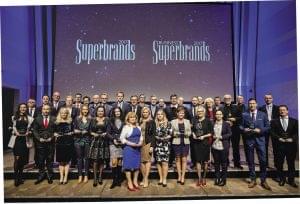Magazine: It isn’t enough to win, the prize should also be retained – but how?
 The Superbrands programme has been rewarding the best brands for 14 years, but there are only a few of these that are able to win the prize year after year. What does it take for a brand to be successful in the market in the long run? From the brands that won the Superbrands recognition in 2018 more than 90 percent had already won before, but only 65 percent won in 2017 too. These two numbers indicate it very well that Superbrands winning brands are planning for the long term, but it is very difficult to keep one’s position in the market. The key to the international success of Superbrands is that the recognition helps both consumers and business decision-makers in making decisions. A recent GfK survey also proves this: 80 percent of consumers associate some kind of positive characteristic with Superbrands, most often trust and quality.
The Superbrands programme has been rewarding the best brands for 14 years, but there are only a few of these that are able to win the prize year after year. What does it take for a brand to be successful in the market in the long run? From the brands that won the Superbrands recognition in 2018 more than 90 percent had already won before, but only 65 percent won in 2017 too. These two numbers indicate it very well that Superbrands winning brands are planning for the long term, but it is very difficult to keep one’s position in the market. The key to the international success of Superbrands is that the recognition helps both consumers and business decision-makers in making decisions. A recent GfK survey also proves this: 80 percent of consumers associate some kind of positive characteristic with Superbrands, most often trust and quality.
The Superbrands prize was established in Hungary to help consumers and business decision-makers, and throughout the years brand owners have come to realise that the recognition helps them to stand out from the crowd in the market. Becoming a Superbrand is a real milestone in the history of a product. At the same time evaluation work doesn’t only bring joy to jury members but also creates obligations: to improve the selection system, be objective, identify brand-related risks and filter out divisive brands. A brand isn’t simply a trademark or a logo as many people think, but the totality of all kinds of perceptions that are connected to the given brand, e.g. awareness of the brand, popularity, reputation, loyalty, risks, etc.
During the pre-selection process one of the most important sources is the national trademark database, while with business brands the Bisnode database is also used; online research and other forms of data collection also help evaluators to select the best brands. During the pre-selection process researchers also rely on the information collected in earlier years. In the case of consumer brands a brand survey is conducted to measure the given brand’s popularity. It must be mentioned, though, that the data collected in the pre-selection process doesn’t affect the jury’s evaluation process.

The Superbrands programme has been rewarding the best brands for 14 years –
our photo taken at last year’s gala event features the representatives of the awarded brands
Each jury member gives points from 1 to 7 to judge the performance of brands, concentrating on factors such as brand tradition, history, market performance, reputation, the company’s goodwill and ethical credit, brand popularity, innovation work and brand strategy. It is needless to say that there are categories where competition is so fierce between brands that the bar must be raised higher – there would be no point in each market player that meets the minimum requirements becoming a Superbrand straight away, because this would decrease the so-called guidance value of the prize.
Quality, being different and trust

Dr. Miklós Bendzsel
honorary president
Hungarian Design Council
Based on survey data from the last three years, 64-75 percent of 100-500 Hungarian consumers are familiar with the Superbrands recognition. What is even more impressive is that 82 percent of them like the programme. The majority of shoppers associate the logo with high-quality products and services. Rewarded brands cover a dozen and half of the most important consumption categories. Although Hungarian brands are represented among Superbrands winners in a smaller proportion than international ones, their share is increasing, thanks to the MagyarBrands programme and the development of the domestic market. Brand building work is different in different product categories, but there are some general trends: environmental consciousness, consumer culture and interest representation and e-commerce are increasingly important.
The role of brand experience in brand building

Andrea Duca
managing partner
HD GROUP Communication Agency
The value of the Superbrands prize for companies is created by the fact that it is a jury of experts that names the winners, having analysed the traditions, market performance and reputation of the brands, plus the goodwill, ethical reputation, popularity, innovation work and brand strategy of the company. It is a good thing that Hungarian brands are closing the gap between international brands and them. This is also very important because recognitions like this can serve as a key tool in employer branding. It is essential that there is no brand building without offering a brand experience to consumers.
Continued inspiration

Zoltán Fekete
secretary general
Branded Goods Association
The number and quality of this year’s entries make it clear that the Superbrands programme itself is a strong and reliable brand. It is a good sign that more and more Hungarian brands want to earn the recognition – and this is especially true for the products and services of small and medium-sized enterprises.
If used well, winning the Superbrands prize and keeping the recognition in the long run can serve as continued inspiration in the domain of business excellence. When evaluating entries, I always examine how strong the relationship is between the given brand and its buyers. Successful brands are in a permanent conversation with consumers, who want brands that can be liked, directness, accessibility, experiences, transparency, ethical business conduct and to be treated as equal partners.
Adaptation, consciousness and results

Zsuzsanna Hermann
managing director-editor-in-chief
Trade magazin
The brand equity of Superbrands keeps growing and winners can gain competitive advantage by using the recognition in their communication. Successful brands adapt themselves to changing market and social requirements, they consciously plan and use their marketing budgets, and focus on building loyalty – all these efforts bring results in the form of successful brands. As for consumers, what I see is growing demand for high-quality, reliable products offered by strong brands.
Processes and results

Bálint Hinora
managing director
Hinora Group
All Superbrands winners are key players in their own segment or industry. What is a brand? A brand is how shoppers feel about a product or service. The brand is the end result of the brand building process. There are stages in brand building and when evaluating the entries, we also analyse the progress a brand has made since the last competition. Coca-Cola is a good example: despite being the market leader, they never lay back and just relax, they know it very well that they must be present in the heads of consumers all the time. This year I saw the most innovative brand building solutions in social media, in the world of influencers and in videos.
A good brand building strategy makes great returns

Dr. Péter Keresztesi
general manager
Modern Media Group
Superbrands isn’t a programme where only multinational and large companies are competing with their brands any more. Any business can be successful that is capable of making products that satisfy consumer needs the most, are innovative, communicate in a targeted and efficient way, and are putting a lot of work into professional brand building. Building a brand requires expertise and costs a lot of money, but if done well, the returns are high. The Superbrands recognition is an important feedback on this work.
Consumers and employees

Zsófia Lakatos
president
Hungarian PR Association
I am glad that the Superbrands recognition has managed to remain a super brand itself throughout the years, which in part is the result of prize winners using the logo more and more consciously in their communication, having realised its value. With the role of employer branding becoming increasingly important, winning the Superbrands recognition can be of great help for a company when recruiting new workers. Why? Because those who belong to Generation Y aren’t choosing a workplace based only on the salary they would get.
There is a lot of work left to do in the SME sector!

Kázmér Nyomárkay
editor-in-chief
K&K Kis- és Középvállalkozások magazinja
In the 14 years of the programme some of the winners earned the recognition more than 10 times. My view is that SMEs and their brands should be represented in a higher proportion among the Superbrands winners. Although the food industry, culture and media are present on the list of winners with many products and services, there are few prize winners from other sectors. How serous is this problem? If we take a look at the top 1 percent of the SME sector, medium-sized companies, the situation is rather bad. There are about 5,000 medium-sized businesses and their growth and competitiveness should be a strategic objective.
Consumers laid the groundwork for the credibility of Superbrands

Dr. István Salgó
general manager
Business Council for
Sustainable Development
in Hungary
Credibility is of utmost importance with the Superbrands programme and my view is that it is consumers who lay the groundwork for this. The fact that companies are taking part in the programme suggests to me that consumers reward earning the Superbrands recognition in their markets. Only those brands can win the prize that shoppers recognise because they offer quality and lasting value – this is guaranteed by the evaluation criteria and the composition of the jury.
It is great news that behind many brands we find small and medium-sized enterprises, who have worked hard for years to become one of the Superbrands. I pay special attention to the visual representation of brands – especially their websites – when evaluating. In this respect many of them still have to make great progress.

Dr. János Serényi
owner, managing director
Értéktrend Consulting
Operating in an ethical way generates profit
All over the world demand is growing fast for cooperating with companies that are operating in an ethical fashion. The most successful brands in Hungary are also doing more and more for good causes in society and the business sphere. Today caring about so-called Environmental, Social and Governance (ESG) matters make returns for companies.
In 2017 Swiss Re, one of the biggest reinsurance companies in the world, invested all of its liquid capital – USD 130 billion – in companies that are performing exceptionally in the domains of environmental consciousness, social responsibility and ethical business management. CEO Guido Fuerer told: companies that are operating unethically have a bigger chance for seeing the value of shares slump. Money feels well at Superbrands winners. This is good not only for them, but – in line with international trends – also for the communities around them.
Competition requires being different!

dr. Gedeon Totth, college professor-department head
Budapest Business School
Although consumer awareness of the Superbrands trademark is growing, there is still room for development. This is no criticism as it takes a lot of time until a recognition like this is ‘imprinted’ in the minds of shoppers – but once it has, it will stay there, especially if it is reinforced positively from time to time.
I think that there is no field of the economy where competition doesn’t make it necessary for companies and brands to differentiate themselves from others in the market. This means that the Superbrands programme is very useful. A growing number of SMEs are participating in the programme. My view is that using new marketing communication tools for brand building and engaging in conversation with consumers are of key importance.
Persistent, creative and innovative development are needed for success

Dr. László Vass
rector
Metropolitan University Budapest
The Superbrands recognition motivates brands for development and at the same time it expresses the satisfaction of consumers. In the last few years more SMEs appeared among the winners. A brand can only become one of the Superbrands if it is excellent and it is backed with superb marketing work.
The key to success is the harmonised and consequent developing of a product and its marketing, and active presence in the market. It rarely happens that a brand becomes a Superbrand overnight. Professional and complex business communication is necessary in brand building and perhaps this is more difficult to do for SMEs. On the other hand, the big players might become lazy in the market. All in all, the best brands know that they can’t allow slowing down in brand building because their product will become obsolete.
It isn’t enough to make quality products, they have to look good too!

Dr. András Vértes
president
GKI
Consumers know less about products than the trade – it is those who work in this business who can tell which products of which companies are in accordance with future needs – but shopper expectations are definitely high these days. However, it isn’t enough to manufacture high-quality products, the goods also have to communicate that they are good. Unusual designs and new-type packaging solutions are very important. I have really bad news: it takes hard work and well-developed, creative ideas to become successful with a product or service.//
Related news
We took you on a flight! (Part 2)
🎧 Hallgasd a cikket: Lejátszás Szünet Folytatás Leállítás Nyelv: Auto…
Read more >Perceived price increase index remains high
🎧 Hallgasd a cikket: Lejátszás Szünet Folytatás Leállítás Nyelv: Auto…
Read more >Industrial production is still declining in Hungary, but it is growing in the EU
🎧 Hallgasd a cikket: Lejátszás Szünet Folytatás Leállítás Nyelv: Auto…
Read more >Related news
The HORECA sector joins forces with Alimentaria+Hostelco to mark the future of hospitality
🎧 Hallgasd a cikket: Lejátszás Szünet Folytatás Leállítás Nyelv: Auto…
Read more >Challenges of the retail sector: retail has become more crisis-resistant
🎧 Hallgasd a cikket: Lejátszás Szünet Folytatás Leállítás Nyelv: Auto…
Read more >How to avoid the hassles of online shopping?
🎧 Hallgasd a cikket: Lejátszás Szünet Folytatás Leállítás Nyelv: Auto…
Read more >






